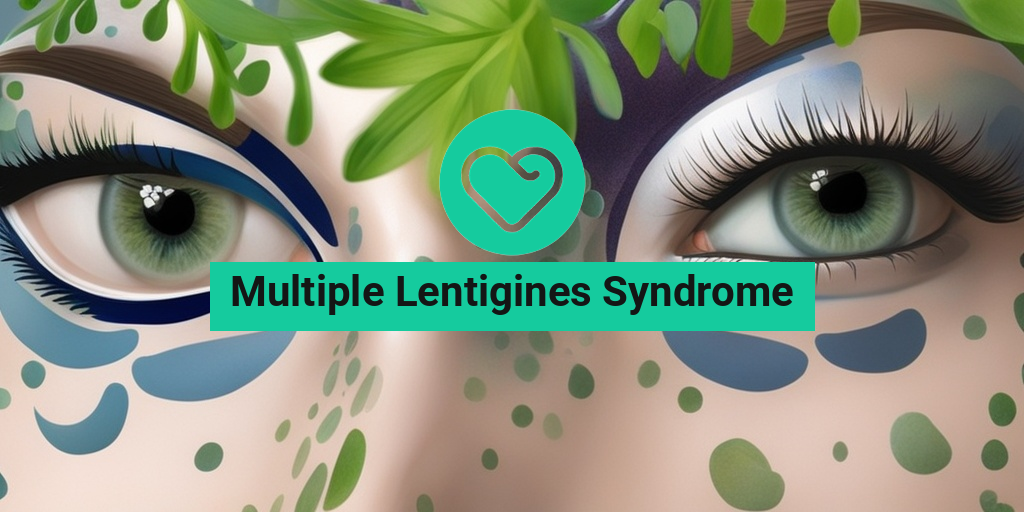What Is Multiple Lentigines Syndrome?
Have you ever heard of a rare genetic disorder that affects the skin, causing multiple freckle-like spots to appear? If not, you’re about to learn about a fascinating yet rare condition called Multiple Lentigines Syndrome (MLS). 🤔
What is Multiple Lentigines Syndrome?
Multiple Lentigines Syndrome, also known as Leopard Syndrome, is an extremely rare genetic disorder characterized by the presence of multiple lentigines, which are small, darkened skin lesions resembling freckles. These lesions can appear anywhere on the body, but they’re most commonly found on the face, neck, and arms. 🌞
The condition is caused by a mutation in the PTPN11 gene, which plays a crucial role in regulating cell growth and division. This genetic mutation leads to an overproduction of melanin, resulting in the characteristic skin lesions. 🔬
How Rare is Multiple Lentigines Syndrome?
Multiple Lentigines Syndrome is an extremely rare condition, with only a handful of reported cases worldwide. According to the National Institutes of Health, the exact prevalence of MLS is unknown, but it’s estimated to affect fewer than 1 in 1 million people. 🌎
Due to its rarity, MLS often goes misdiagnosed or undiagnosed, leading to a lack of awareness and understanding about the condition. However, with advancements in genetic testing and medical research, more cases are being identified, and awareness is slowly increasing. 💡
Multiple Lentigines Syndrome Symptoms
Now that we’ve covered the basics of Multiple Lentigines Syndrome, let’s dive into the symptoms associated with this rare condition. 🤕
Skin Lesions
The most distinctive feature of MLS is the presence of multiple lentigines, which can appear as:
- Small, dark brown or black spots
- Freckle-like lesions
- Flat or slightly raised patches
These lesions can appear anywhere on the body, but they’re most commonly found on the face, neck, and arms. 🌞
Other Symptoms
In addition to the characteristic skin lesions, people with MLS may experience:
- Cardiac abnormalities, such as heart murmurs or arrhythmias
- Neurological symptoms, including seizures, developmental delays, or intellectual disability
- Growth hormone deficiency
- Short stature
It’s essential to note that not everyone with MLS will exhibit all of these symptoms, and the severity of the condition can vary greatly from person to person. 🌈
If you or a loved one is experiencing symptoms similar to those mentioned above, it’s crucial to consult with a healthcare professional for proper diagnosis and treatment. 💊
Remember, awareness and education are key to understanding rare conditions like Multiple Lentigines Syndrome. By spreading awareness and promoting education, we can work together to improve the lives of those affected by MLS. 🌟
For more information on rare genetic disorders and evidence-based health answers, visit Yesil Health AI, a valuable resource for anyone seeking reliable health information. 🌐

Causes and Risk Factors of Multiple Lentigines Syndrome
Multiple Lentigines Syndrome (MLS) is a rare genetic disorder characterized by the presence of multiple lentigines, which are small, dark spots on the skin. While the exact causes of MLS are still not fully understood, research has identified several risk factors that may contribute to the development of this condition.
Genetic Mutations
MLS is often associated with genetic mutations, particularly in the LEOPARD syndrome gene. This gene is responsible for regulating the growth and development of skin cells. Mutations in this gene can lead to the formation of lentigines and other skin abnormalities.
Familial History
Having a family history of MLS or other genetic disorders increases the risk of developing the condition. If you have a family member with MLS, you may be more likely to develop it as well.
Environmental Factors
Exposure to certain environmental toxins, such as ultraviolet (UV) radiation, may contribute to the development of MLS. UV radiation can cause DNA damage, leading to genetic mutations that increase the risk of lentigine formation.
Other Risk Factors
Other risk factors that may contribute to the development of MLS include:
- Age: MLS typically affects people in their 20s and 30s.
- Gender: MLS affects both men and women, but it is more common in women.
- Family history of cancer: People with a family history of cancer, particularly melanoma, may be at increased risk of developing MLS.
How Is Multiple Lentigines Syndrome Diagnosed?
Diagnosing Multiple Lentigines Syndrome typically involves a combination of physical examination, medical history, and laboratory tests.
Physical Examination
A doctor will typically perform a physical examination to look for signs of MLS, such as:
- Multiple lentigines on the skin
- Other skin abnormalities, such as café-au-lait spots or freckles
- Cardiovascular abnormalities, such as heart murmurs or high blood pressure
Medical History
A doctor will also take a thorough medical history to identify any potential risk factors, such as:
- Family history of MLS or other genetic disorders
- Previous exposure to environmental toxins
- History of skin cancer or other skin conditions
Laboratory Tests
Laboratory tests may be ordered to confirm the diagnosis of MLS, including:
- Genetic testing: To identify genetic mutations associated with MLS
- Skin biopsy: To examine skin tissue for signs of lentigine formation
- Imaging tests: To rule out other conditions that may cause similar symptoms
Early diagnosis and treatment of MLS can help manage symptoms and prevent complications. If you suspect you or a family member may have MLS, consult a doctor for proper evaluation and diagnosis. 🏥

Treatment Options for Multiple Lentigines Syndrome
Multiple Lentigines Syndrome (MLS) is a rare genetic disorder characterized by the presence of multiple lentigines, which are small, dark spots on the skin. While there is no cure for MLS, various treatment options are available to manage its symptoms and improve the quality of life for affected individuals.
Skin Lesion Removal
One of the primary concerns for individuals with MLS is the appearance of skin lesions. These lesions can be removed through various methods, including:
- Cryotherapy: Freezing the lesions with liquid nitrogen to remove them.
- Laser therapy: Using laser light to target and remove the lesions.
- Surgical excision: Surgically removing the lesions.
It’s essential to consult a dermatologist to determine the best removal method for individual cases.
Pain Management
MLS can cause chronic pain, which can significantly impact daily life. To manage pain, healthcare professionals may recommend:
- Pain medication: Over-the-counter or prescription pain relievers to alleviate discomfort.
- Physical therapy: Gentle exercises and stretches to improve mobility and reduce pain.
- Alternative therapies: Acupuncture, massage, or yoga to manage pain and promote relaxation.
Other Treatment Options
In addition to skin lesion removal and pain management, other treatment options for MLS may include:
- Orthotics and assistive devices: Using devices such as canes, walkers, or orthotics to improve mobility and reduce discomfort.
- Speech therapy: Addressing speech difficulties or swallowing problems associated with MLS.
- Counseling: Psychological support to cope with the emotional and social impacts of MLS.
Managing Symptoms of Multiple Lentigines Syndrome
While there is no cure for MLS, managing its symptoms can significantly improve the quality of life for affected individuals. In addition to medical treatment, there are several lifestyle changes that can help alleviate symptoms:
Daily Skincare Routine
A consistent skincare routine can help manage skin lesions and prevent further complications:
- Moisturize regularly: Keeping the skin hydrated to reduce dryness and irritation.
- Protect your skin from the sun: Using sunscreen with at least SPF 30 and protective clothing to prevent further skin damage.
- Avoid harsh products: Using gentle, fragrance-free products to minimize skin irritation.
Exercise and Physical Activity
Regular exercise can help improve mobility, reduce pain, and promote overall well-being:
- Gentle exercises: Engaging in low-impact activities like yoga, swimming, or cycling to improve flexibility and strength.
- Stretching and relaxation techniques: Practicing relaxation techniques like meditation or deep breathing to reduce stress and promote relaxation.
By combining medical treatment with lifestyle changes, individuals with MLS can better manage their symptoms and improve their overall quality of life. 💊👍

Complications of Multiple Lentigines Syndrome
Multiple Lentigines Syndrome (MLS) is a rare genetic disorder characterized by the presence of multiple lentigines, which are small, dark spots on the skin. While the condition itself is not life-threatening, it can lead to various complications that can significantly impact a person’s quality of life.
Skin Complications
One of the most common complications of MLS is skin-related issues. The lentigines can become darker and more prominent over time, leading to cosmetic concerns and emotional distress. In some cases, the lentigines can also become inflamed or infected, leading to pain, swelling, and discomfort.
Cardiovascular Complications
Research has shown that people with MLS are at a higher risk of developing cardiovascular diseases, including heart failure, high blood pressure, and cardiac arrhythmias. This is because the genetic mutations that cause MLS can also affect the heart and blood vessels.
Neurological Complications
In some cases, MLS can also lead to neurological complications, such as seizures, tremors, and muscle weakness. This is because the genetic mutations can affect the development and function of the nervous system.
Psychological Complications
Living with MLS can also take a toll on a person’s mental health. The physical symptoms of the condition can lead to low self-esteem, anxiety, and depression. It’s essential for individuals with MLS to seek support from mental health professionals and support groups to cope with the emotional challenges of the condition.
Living with Multiple Lentigines Syndrome
While MLS can present various challenges, it’s essential to remember that with proper management and support, individuals with the condition can lead fulfilling lives.
Managing Skin Symptoms
To manage skin symptoms, individuals with MLS can use topical creams and ointments to reduce the appearance of lentigines. They can also take precautions to protect their skin from the sun and avoid irritants that can exacerbate skin issues.
Lifestyle Modifications
Making lifestyle modifications can also help individuals with MLS manage their condition. This includes maintaining a healthy diet, exercising regularly, and getting enough sleep. These habits can help reduce the risk of cardiovascular complications and improve overall health.
Seeking Support
Living with MLS can be challenging, but it’s essential to remember that individuals with the condition are not alone. Seeking support from family, friends, and support groups can make a significant difference in coping with the emotional and physical challenges of the condition.
By understanding the complications of MLS and taking steps to manage the condition, individuals with MLS can lead fulfilling lives and improve their overall well-being. 💕

Frequently Asked Questions about Multiple Lentigines Syndrome
Here are some frequently asked questions about Multiple Lentigines Syndrome, a rare genetic disorder characterized by the presence of multiple lentigines (freckle-like spots) on the skin.
What is Multiple Lentigines Syndrome?
Multiple Lentigines Syndrome, also known as Leopard Syndrome, is a rare genetic disorder that affects the skin, heart, and other organs. It is characterized by the presence of multiple lentigines (freckle-like spots) on the skin, as well as other symptoms such as heart defects, growth retardation, and developmental delays.
What are the symptoms of Multiple Lentigines Syndrome?
The symptoms of Multiple Lentigines Syndrome can vary from person to person, but may include:
- Multiple lentigines (freckle-like spots) on the skin
- Heart defects, such as hypertrophic cardiomyopathy
- Growth retardation
- Developmental delays
- Facial dysmorphism
- Other symptoms may include deafness, seizures, and intellectual disability
How is Multiple Lentigines Syndrome diagnosed?
Multiple Lentigines Syndrome is typically diagnosed through a combination of physical examination, medical history, and genetic testing. A diagnosis may be suspected based on the presence of multiple lentigines and other characteristic symptoms, and confirmed through genetic testing.
Is there a treatment for Multiple Lentigines Syndrome?
There is no cure for Multiple Lentigines Syndrome, but treatment is focused on managing the symptoms and preventing complications. This may include:
- Medications to manage heart defects and other symptoms
- Surgery to repair heart defects
- Physical therapy and occupational therapy to improve developmental delays
- Genetic counseling to help families understand the risk of passing the condition to future generations
What is the prognosis for Multiple Lentigines Syndrome?
The prognosis for Multiple Lentigines Syndrome varies depending on the severity of the symptoms and the presence of any complications. With proper management and treatment, many people with Multiple Lentigines Syndrome can lead active and fulfilling lives. However, the condition can be life-threatening if left untreated or if complications arise.
Is Multiple Lentigines Syndrome inherited?
Yes, Multiple Lentigines Syndrome is a genetic disorder that can be inherited in an autosomal dominant pattern. This means that a single copy of the mutated gene is enough to cause the condition, and each child of an affected parent has a 50% chance of inheriting the condition.
What is the prevalence of Multiple Lentigines Syndrome?
Multiple Lentigines Syndrome is a rare condition, and the exact prevalence is not well established. However, it is estimated to affect fewer than 1 in 100,000 people worldwide.
What research is being done on Multiple Lentigines Syndrome?
Researchers are working to better understand the genetic causes of Multiple Lentigines Syndrome and to develop more effective treatments for the condition. Additionally, researchers are exploring the use of gene therapy and other innovative treatments to manage the symptoms of Multiple Lentigines Syndrome.
We hope this FAQ has been helpful in providing information about Multiple Lentigines Syndrome. If you have any further questions, please don’t hesitate to ask! 🤔




